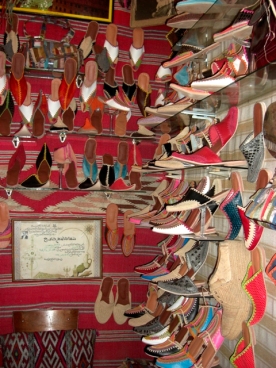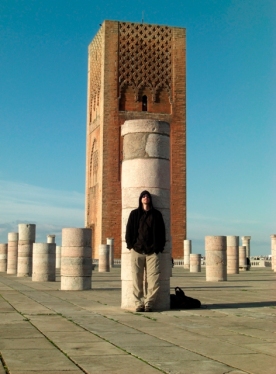Monday, January 26, 2009
Saturday, January 24, 2009
Atlas Mountains: Berber Country
We did a road trip through the Atlas Mountains. Dad wanted to see the Berber people. Camels and monkeys made up the wildlife in the area. Plenty of waterfalls down the side of the mountain, often gushing over the roads. If not for the 4-wheel drive of the car service, it would have been quite sketchy to travel. I was amazed at the little cottages that were built in the crevices of the mountains. Many connected to the only paved road via rope bridges like the one above.
MAP
Thursday, January 22, 2009
Efran: Maroc Swiss Alps, Yodel If You Can!
Wednesday, January 21, 2009
Volubilis and Moulay Idriss
Tuesday, January 20, 2009
Rabat: Funky Cold Medina

We left the tower to explore the Medina of Rabat. The initially sparsely populated, narrow streets of medina offered fruit, shoes, and various types of bread cooked on large griddles. Stray cats lurked or fought in the streets to the entertainment of feline friend, my Studly Hubby.
In the main part of the markets, were souks (stalls, shops) where local residents would buy fabrics, clothing, spices electronics. The more exotic food offerings in the medina included hooves and goat heads. Some souks had obvious appeal to tourists carrying lamps, hookahs, hand stitched slippers, hand- painted pottery and richly hued leathers.
The merchants at this market were low-key and did not harass or pressure sales. This would be in stark contrast of the markets we would see in other cities. A stroll through the casbah near the medina led us to a Moorish cafe overlooking the water. The cafe consisted mainly of locals enjoying the Moroccan signature mint tea. A freelance pastry peddler would come by the table with a large selection of cookies.
Another long walk through the streets, we were exhausted and hungry. Mom, Dad, Hubby and I went to look for a restaurant for dinner after leaving the Medina. It was harder than we thought. Moroccans as a culture don’t eat out for dinner that often, but after years of French occupation, patisseries and cafes were abundant. A cafe latte and croissant were easily found when a good tagine was not.
Monday, January 19, 2009
Meknes: Taxis, Turtles & Hammams
In the morning, after another chaotic trip through the train station, we took the two hour ride to the city of Meknes.
My sister Clara’s friend Jamila has an uncle from this town who will be serving as our guide. He is a charming gentleman who goes by the name “Rani” and met us as the train station. We found a large taxi that transported all of us to the Riad including the mountain of luggage.
Morocco generally has two types of taxis. The petit-taxis, are little blue cars that transport a maximum of three passengers. The grande-taxis, Mercedes that are 25 years old or more, transport as many and as much as it can possibly fit. Grande-taxis are also licensed to take you to other cities while the smaller ones are not. We hired a grande-taxi to transport Rani, Adam, Mom and Dad and myself with all of the luggage (bungee-strapped into the overfilled trunk) to go to the Riad Fellousia.
Sunday, January 18, 2009
Rabat: Planes, Trains and Jackie Chan


Upon arrival at Casablanca Mohammed airport, I discovered that my luggage never made it on the plane. Through the limited English of the luggage officer and the limited French on my part, we came to the conclusion that Royal Air Maroc has no
My parents were already waiting outside the gate to greet us after their flight from Mali. As we were catching a train to the next town of Rabat, we couldn’t stay and argue with the airline officials that much longer and had to wait until the next day to call with a tracking number. We were catching a train to the next town of Rabat.
Little did I know that my parents would carry with them five large suitcases in addition to several smaller bags. I had been equally uninformed that Adam and I were expected to assist in carrying these from train to train in this North African country. One of these suitcases contained a fifteen pound sacred salt slab, a gift from a tribal chief in Mali.
The trains are quite comfortable, and convenient. First class cars are only ten percent more expensive than the regular cars are worth it for the comfort, privacy and extra storage space.
Less convenient, are the unmarked trains and low key announcements on the train itself. It was easy to miss the intended stop or know which end of the train you want. A family of obvious tourists dragging a total of eleven bags up and down a carved tile platform multiple times was a source of hilarious audible and visual entertainment for the locals.
After checking into the surprisingly chic Scheherazade Mercure hotel on a quiet side street in Rabat, Adam and I crashed for a much needed nap. We woke up in the afternoon to grab a quick lunch at a diner down the street.
The diner had a rack of roasting chickens, yellow from the liberal use of turmeric, cumin and a bunch of other spices common to the country. A whole chicken (including innards in sauce), plate of soupy rice and capers, fries and giant disks of bread were 80 dirhams ($ 10 US). It was hearty, tasty and more than the four of us could eat. We received exceptionally gracious service, which we felt was unusual, beyond the normally nice service that was typical. My father discovered the reason later, when a waiter ran up to him, shook his hand and called him “Jackie Chan”.
After lunch, my family and I walked towards Hassan Tower. It was a historical site of a red sandstone minaret of an incomplete mosque. It was originally intended by sultan Yacoub al-Mansourto be the world’s largest in 1199, but he died during construction. Locals were taking leisurely strolls in this quiet courtyard.













